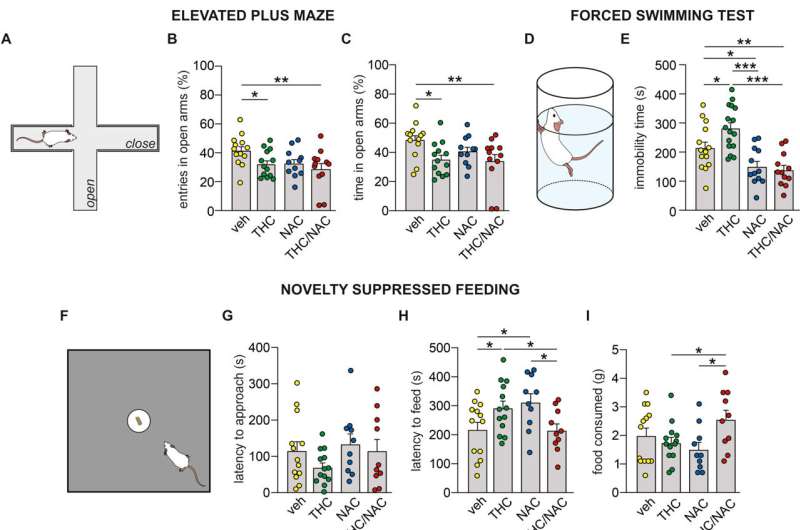
Effect of NAC on anxiety and depression-like symptoms induced by adolescent THC exposure. Source: Biological Psychiatry Global Open Science (2024). DOI: 10.1016/j.bpsgos.2024.100361
Western University researchers have found that an over-the-counter natural health product could help counteract the negative effects of heavy cannabis use among adolescents ages 12 to 17, including depression, anxiety and reduced motivation in adulthood.
In a new paper published in Biological Psychiatry Global Open ScienceResearchers Marta De Felice and Steven Laviolette from Schulich School of Medicine and Dentistry demonstrated in animal models that an intervention with the antioxidant N-acetylcysteine (NAC) can reduce the detrimental mental health effects of chronic cannabis use in later life. NAC is available as an over-the-counter natural health product in Canada and is commonly used to treat acetaminophen overdose.
Their findings also shed light on the mechanisms behind these mental health effects and offer hope for future treatment strategies.
Chronic cannabis use in adolescents can lead to a lack of motivation, reduced enjoyment of daily activities, and other depressive effects, also known as “amotivation syndrome.” Currently, there are no known intervention strategies to counteract these psychiatric side effects.
Studies have shown that NAC, an amino acid known for its antioxidant properties and for supporting respiratory and liver health, effectively counteracts oxidative stress caused by cell-damaging unstable atoms and antioxidant imbalances that can lead to a variety of diseases. NAC also reduces high levels of glutamate, an excitatory neurotransmitter that sends chemical signals from neurons to cells.
In the study, the researchers tested the effectiveness of NAC in animal models, and according to lead author De Felice, a postdoctoral researcher in the Department of Anatomy and Cell Biology, the results showed that NAC acts as a protective agent by neutralizing oxidative stress and regulating glutamate levels to maintain normal function in a part of the brain called the nucleus accumbens.
“The nucleus accumbens is a brain region that regulates mood disorders and addictions and is responsible for motivated behavior,” De Felice says, “which is why testing NAC in this region was so important in this study, because it’s a key region that mediates the effects of drugs that are perceived as rewarding.”
The researchers believe that normalizing the function and activity of this brain region may prevent the development of depression and anxiety phenotypes (the genes responsible for these traits).
The findings of this study also provide a greater understanding of how cannabis exposure, by affecting oxidative processes and neurotransmitter function in brain regions, may negatively impact the brain’s ability to respond appropriately to motivational cues.
“It’s exciting that by identifying increased oxidative stress and glutamate toxicity in the brain, we’ve identified one of the key mechanisms behind this phenomenon,” said Laviolette, a professor in the Department of Anatomy and Cell Biology. “NAC intervention is thought to be very effective in preventing many of these effects, and it’s also a very safe and readily available supplement.”
The researchers hope to move this into clinical trials within the next few years to provide adolescents with an effective intervention strategy to address the long-term effects of cannabis exposure on mental health outcomes.
For more information:
Marta De Felice et al. “Effects of cannabinoid exposure on striatal anxiety and depression-like pathophysiology in adolescents are prevented by the antioxidant N-acetylcysteine” Biological Psychiatry Global Open Science (2024). DOI: 10.1016/j.bpsgos.2024.100361
Provided by University of Western Ontario
Quote: Researchers Discover Potential Treatment to Counteract the Mental Health Effects of Cannabis (July 29, 2024) Retrieved July 29, 2024 from https://medicalxpress.com/news/2024-07-potential-therapeutic-counteract-mental-health.html
This document is subject to copyright. It may not be reproduced without written permission, except for fair dealing for the purposes of personal study or research. The content is provided for informational purposes only.


